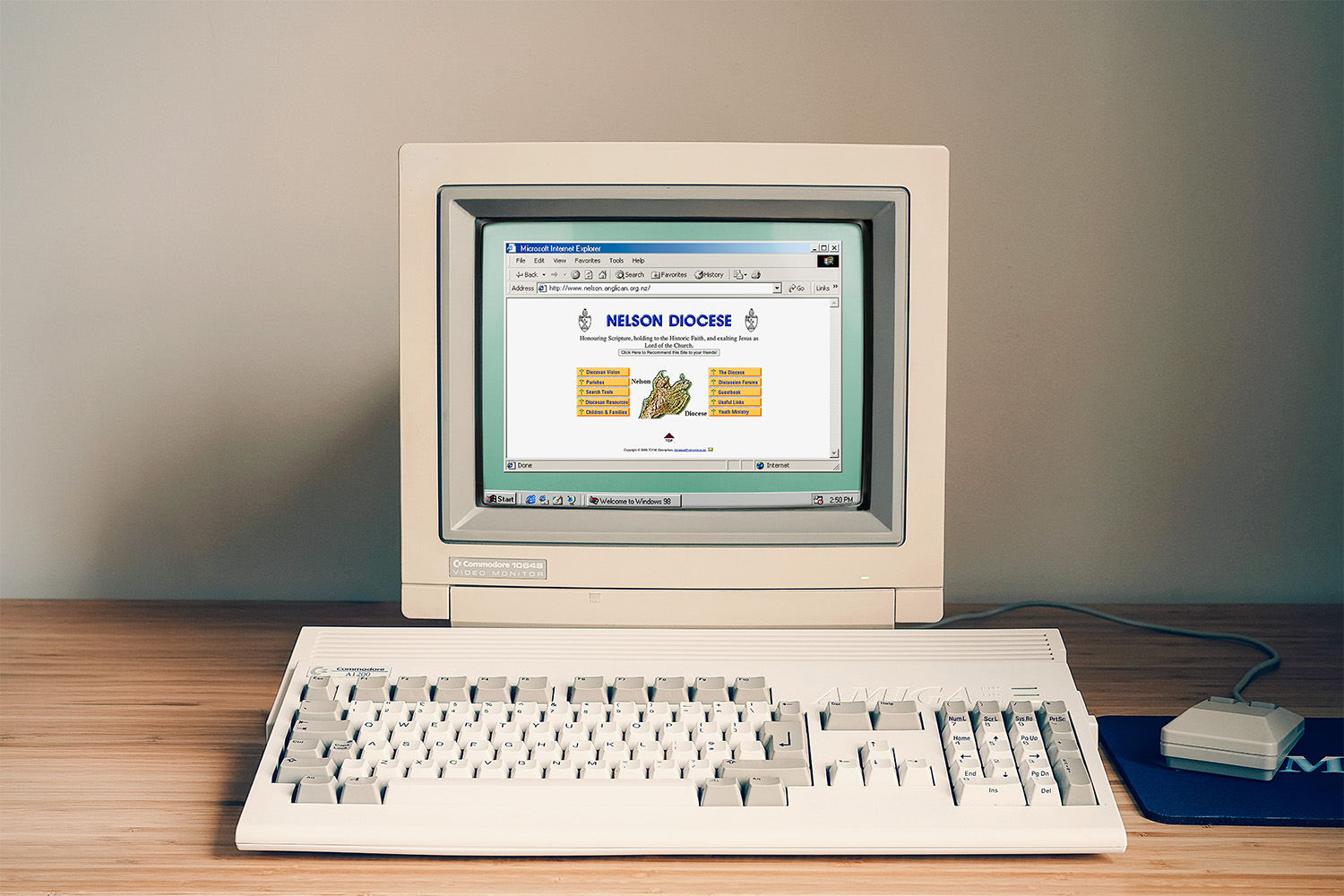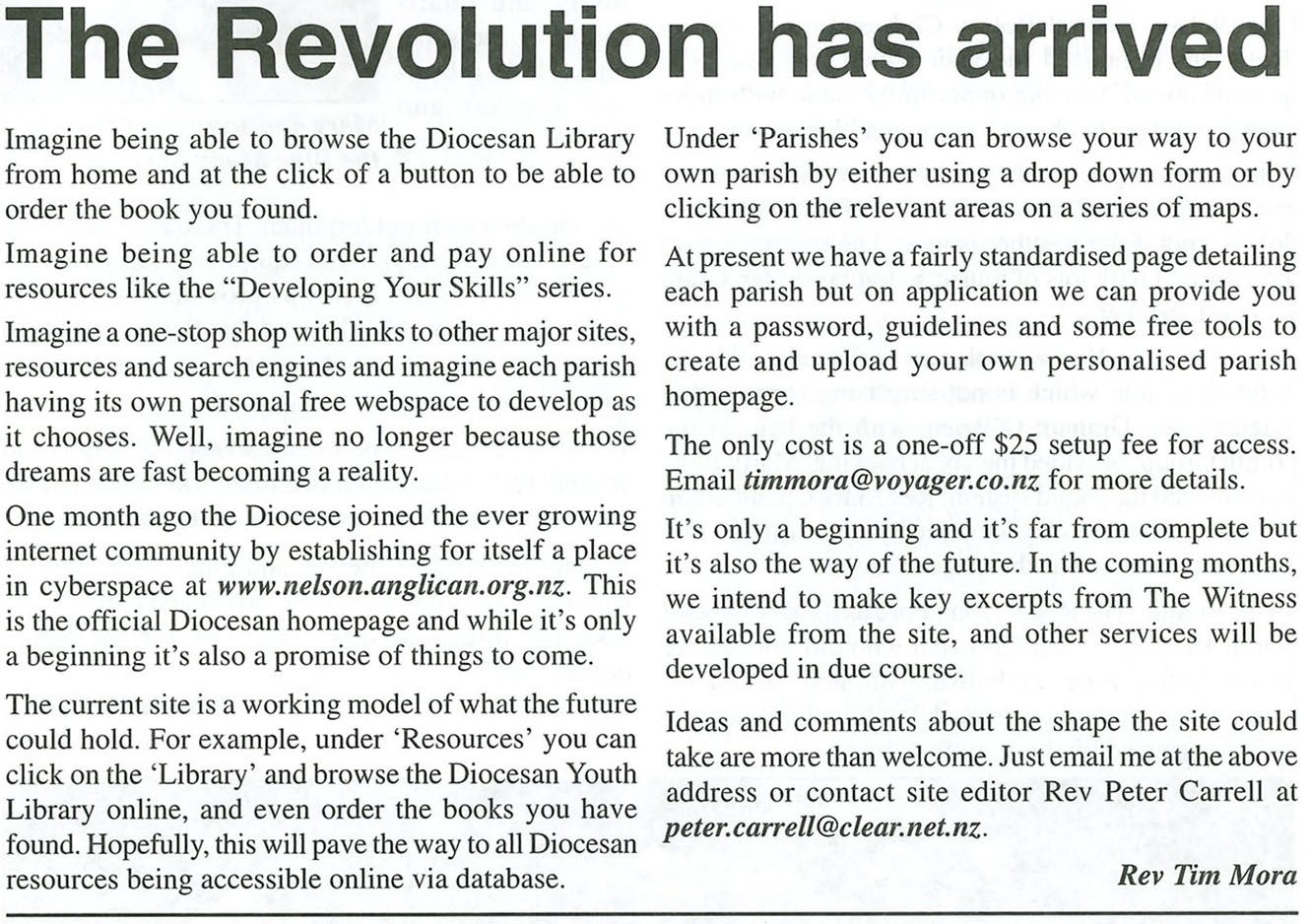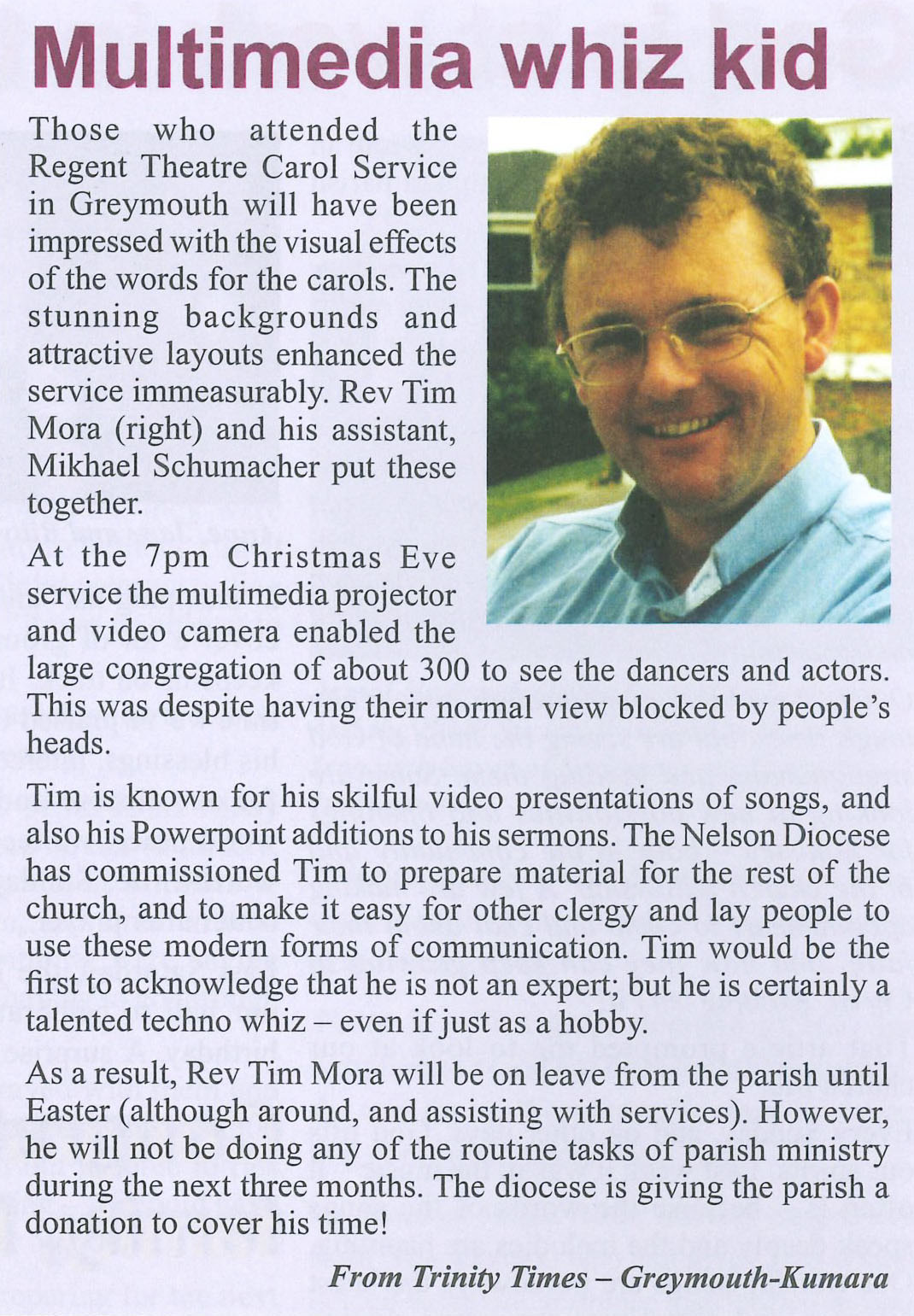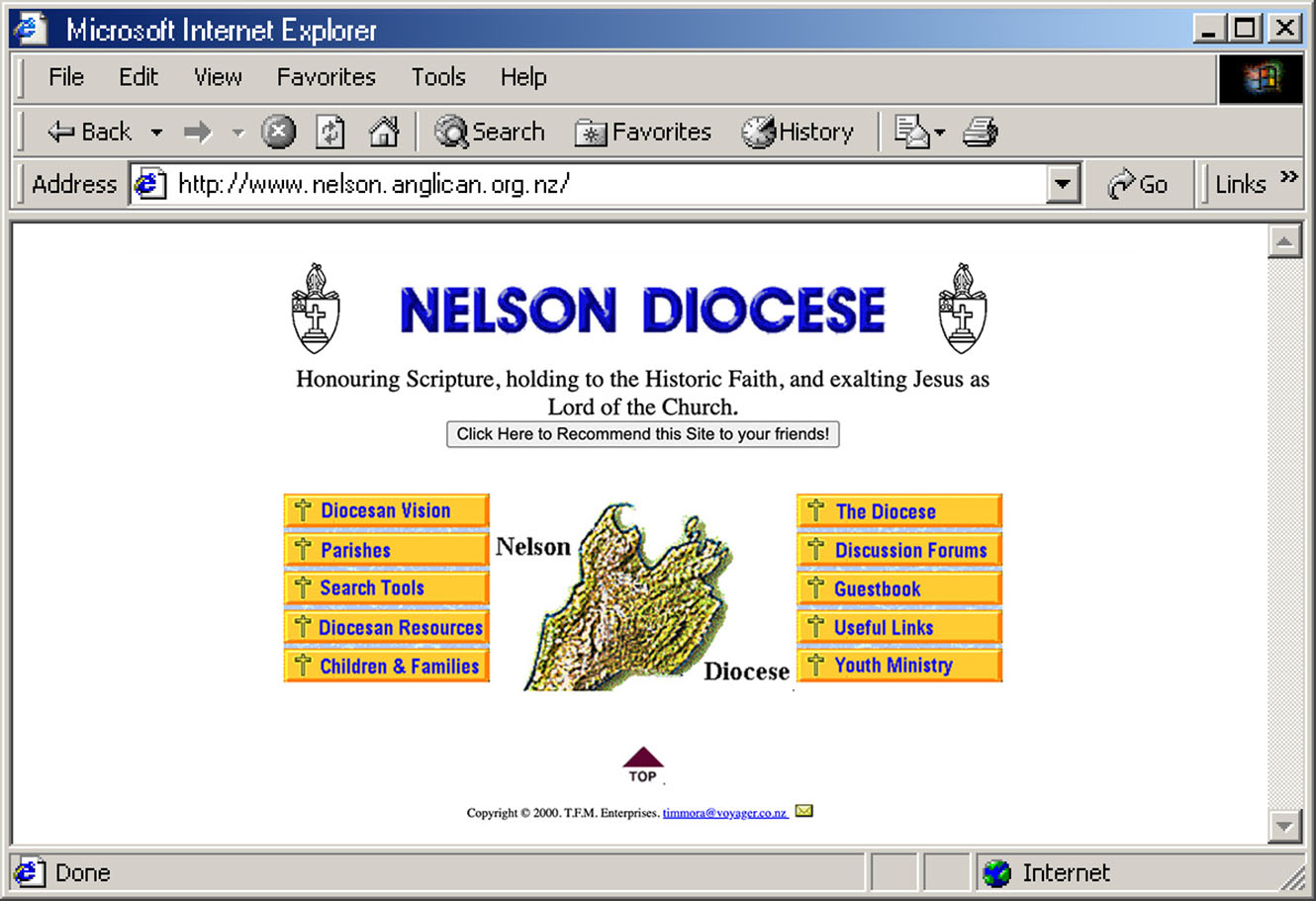
Over the past few months, I had the pleasure of building a new website for Cobden-Runanga Anglican Parish. With the parish’s new branding recently completed, it was a good time for a refresh. The website needed to be simpler to update, easy to navigate, and better suited to parish life today.
Now, after input and approval from the vestry team, the new site sits proudly online in its fresh colours, filled with photos of the parish taken by Greymouth photographer Stewart Nimmo and myself. Every blurb has been written with care to inform and warmly invite others into the life of the parish, thanks to the thoughtful work of Sue Roper. It’s been a genuine team effort.
But this moment also feels like something of a full circle.
The previous site – built in 2004 – was designed by none other than the parish vicar, Ven Tim Mora. Long before Squarespace and Canva made things easier for the rest of us, Tim was already coding websites and enhancing services with video and PowerPoint. He built our very first diocesan website and introduced it in The Witness in May 2000, writing that the diocese had “joined the ever growing internet community by establishing for itself a place in cyberspace”.

By 2003, he had earned the nickname “multimedia whiz kid” for his digital prowess!

So, while it was time for a website refresh, it’s only fitting we take a moment to appreciate the man who first got the parish – and the entire diocese – online.
Tim: I was the first person at St John’s College to get an email address. I had a modem in my computer before the internet and was interacting with bulletin boards – text-based online forums where you’d dial in and post or comment on topics. I used to build HTML conference sites for registrations and use PayPal for payments.
I also sold PowerPoint backgrounds with original photo work from Stewart and myself. We’d sell a CD with 60 high-res images that people could use in their presentations. It was a new thing then – digital photography hadn’t taken off, so we scanned Stew’s film photography. I had one of the very early digital cameras. It was five megapixels, cutting edge at the time!
I had the very first smartphone too, which was a Palm Treo. It was a PDA, or personal digital assistant – which was like a handheld electronic diary – combined with a phone. You could sync it with your computer.
Tim: When I came to Greymouth in ’98, the diocese didn’t have any online presence. I just did it myself – built a diocesan site, with a photo, contact details, and a map for every parish. You’d click on the map, it would take you to a deanery, and then to a parish – just a small page for each.

It wasn’t pretty, but it was functional. A start. Then as websites became more mainstream, the dio decided to build their first official one.
Then in 2004 I built a more multifunctional parish website and one for The Shed youth group.
Tim: Things have changed massively. At first, the internet was static – just info online. Now it’s dynamic: social media, AI, everything is interactive. Churches have kept up in many ways, though. We used to make youth group videos, first on VHS, then digital video. And in Cobden, we do livestreaming and have people join via Zoom, that sort of thing.
I could have gone into IT, but I chose ministry. IT is still a passion though, and sometimes the two overlap. I built one of the first online Bibles in New Zealand – the first Māori Bible translation online. Dr Cleve Barlow from Auckland University had transcribed the old KJV Māori Bible with his students. He gave me a copy, and I formatted it to work with one of the earliest computer Bible programmes.
Tim: And on one level, I’m quite happy to leave it behind. Things have taken off and got a life of their own, and AI is just the next big jump. But I think of myself as a digital and tech pioneer for the kingdom of God.
Check out other articles in the
series below.
More articles in the
series are to come.
We have invited these writers to share their experiences, ideas and opinions in the hope that these will provoke thought, challenge you to go deeper and inspire you to put your faith into action. These articles should not be taken as the official view of the Nelson Diocese on any particular matter.

Over the past few months, I had the pleasure of building a new website for Cobden-Runanga Anglican Parish. With the parish’s new branding recently completed, it was a good time for a refresh. The website needed to be simpler to update, easy to navigate, and better suited to parish life today.
Now, after input and approval from the vestry team, the new site sits proudly online in its fresh colours, filled with photos of the parish taken by Greymouth photographer Stewart Nimmo and myself. Every blurb has been written with care to inform and warmly invite others into the life of the parish, thanks to the thoughtful work of Sue Roper. It’s been a genuine team effort.
But this moment also feels like something of a full circle.
The previous site – built in 2004 – was designed by none other than the parish vicar, Ven Tim Mora. Long before Squarespace and Canva made things easier for the rest of us, Tim was already coding websites and enhancing services with video and PowerPoint. He built our very first diocesan website and introduced it in The Witness in May 2000, writing that the diocese had “joined the ever growing internet community by establishing for itself a place in cyberspace”.

By 2003, he had earned the nickname “multimedia whiz kid” for his digital prowess!

So, while it was time for a website refresh, it’s only fitting we take a moment to appreciate the man who first got the parish – and the entire diocese – online.
Tim: I was the first person at St John’s College to get an email address. I had a modem in my computer before the internet and was interacting with bulletin boards – text-based online forums where you’d dial in and post or comment on topics. I used to build HTML conference sites for registrations and use PayPal for payments.
I also sold PowerPoint backgrounds with original photo work from Stewart and myself. We’d sell a CD with 60 high-res images that people could use in their presentations. It was a new thing then – digital photography hadn’t taken off, so we scanned Stew’s film photography. I had one of the very early digital cameras. It was five megapixels, cutting edge at the time!
I had the very first smartphone too, which was a Palm Treo. It was a PDA, or personal digital assistant – which was like a handheld electronic diary – combined with a phone. You could sync it with your computer.
Tim: When I came to Greymouth in ’98, the diocese didn’t have any online presence. I just did it myself – built a diocesan site, with a photo, contact details, and a map for every parish. You’d click on the map, it would take you to a deanery, and then to a parish – just a small page for each.

It wasn’t pretty, but it was functional. A start. Then as websites became more mainstream, the dio decided to build their first official one.
Then in 2004 I built a more multifunctional parish website and one for The Shed youth group.
Tim: Things have changed massively. At first, the internet was static – just info online. Now it’s dynamic: social media, AI, everything is interactive. Churches have kept up in many ways, though. We used to make youth group videos, first on VHS, then digital video. And in Cobden, we do livestreaming and have people join via Zoom, that sort of thing.
I could have gone into IT, but I chose ministry. IT is still a passion though, and sometimes the two overlap. I built one of the first online Bibles in New Zealand – the first Māori Bible translation online. Dr Cleve Barlow from Auckland University had transcribed the old KJV Māori Bible with his students. He gave me a copy, and I formatted it to work with one of the earliest computer Bible programmes.
Tim: And on one level, I’m quite happy to leave it behind. Things have taken off and got a life of their own, and AI is just the next big jump. But I think of myself as a digital and tech pioneer for the kingdom of God.
Check out other articles in the
series below.
More articles in the
series are to come.